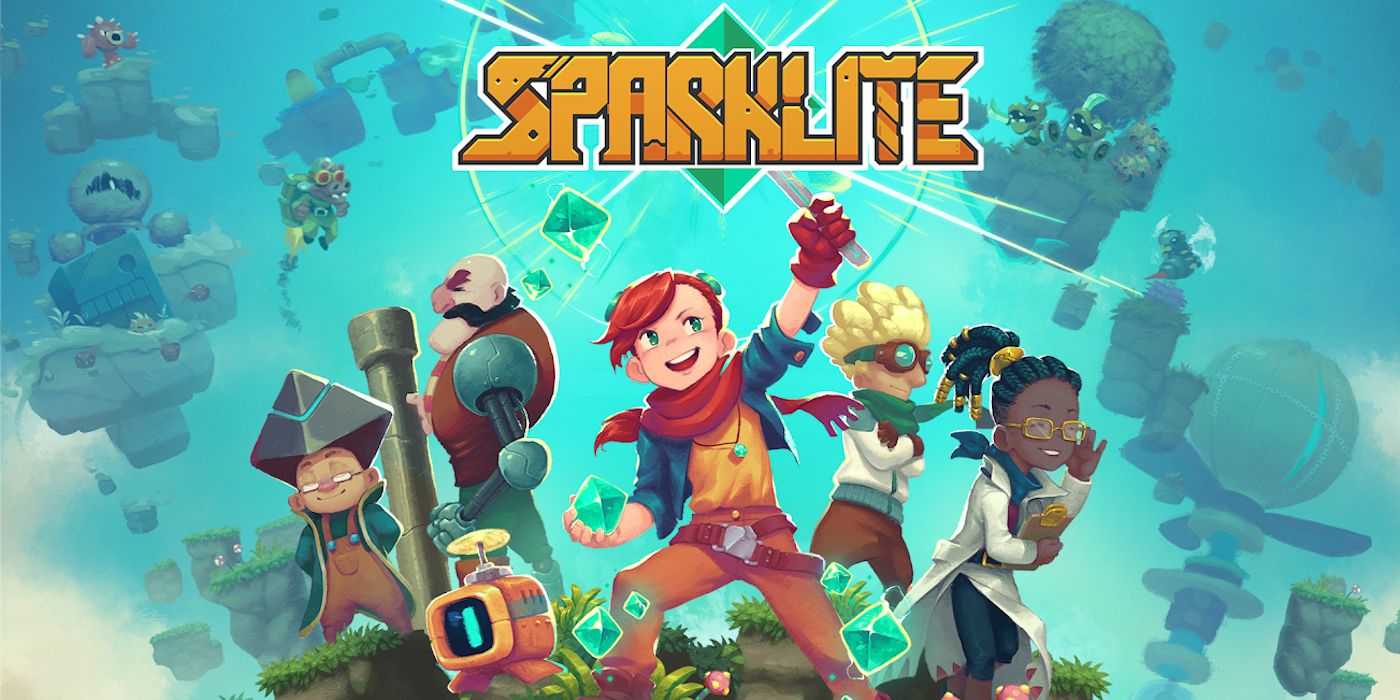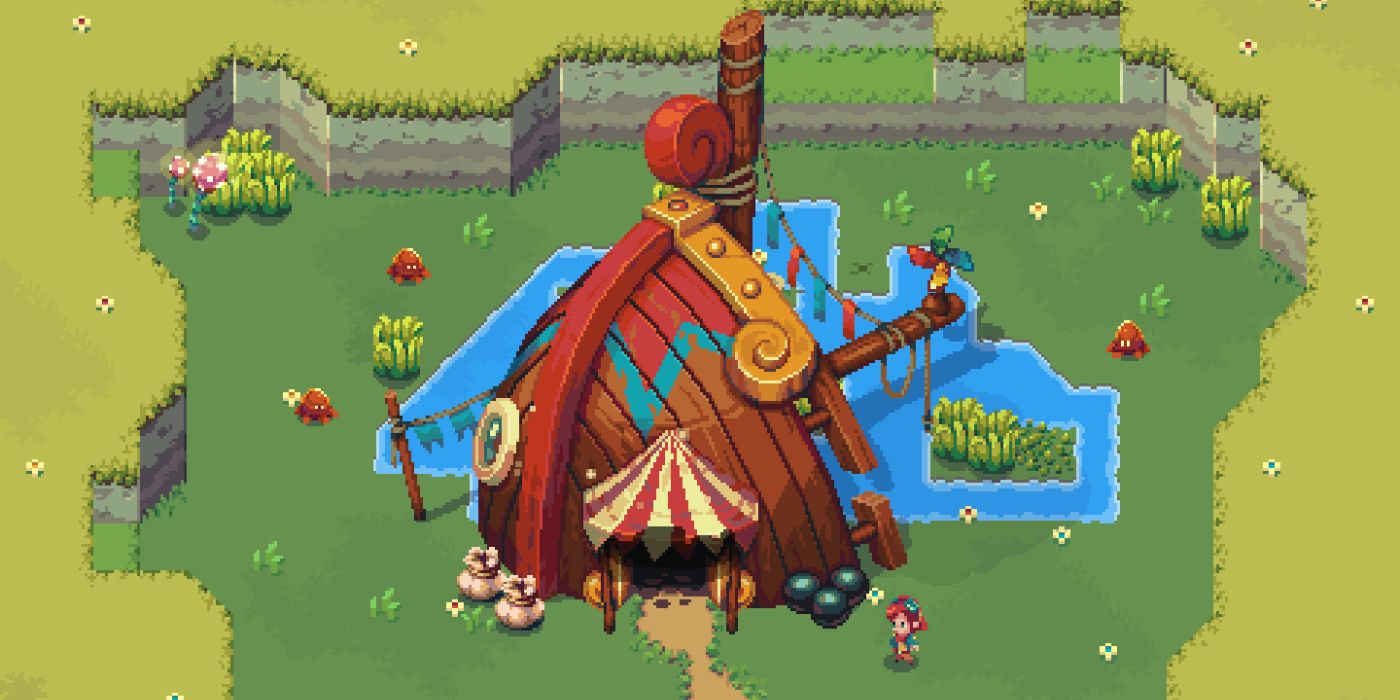
Sparklite aims to leverage its stunning visual style and roguelite mechanics to create a refreshing adventure with a strong environmental message. Indie developer Red Blue Games is teaming up with publisher Merge Games for their upcoming release, Sparklite. A peppy action/adventure title inspired by timeless classics like A Link to the Past and modern hits like Rogue Legacy, Sparklite has the lofty goal of combining a unique setting, timeless visuals, and a small dash of hardcore roguelite elements to create a new titan in the indie space.
At a Merge Games press event in a New York City office, we got to sit down and try out a hands-on demo of Sparklite. Our extensive look at the game can be viewed in its entirety in the YouTube embed below. Guided along by Red Blue Games co-owner and developer Kevin Mabie, we got the chance to explore the opening hour of the game, play with some of Sparklite's cool gadgets, and get completely owned, multiple times, by the first boss.
The world of Sparklite has a surprising amount of lore built into it, taking a familiar fantasy setting and adding enough wrinkles for it to stand on its own merits. Mabie promised us there will plenty of story-based secrets that to be revealed as players progress through the story. The once-peaceful land of Geodia has been ravaged by the greedy Baron Mining Corporation, who harvest the precious natural resource, the titular Sparklite. The Baron's ultimate goal is to harness the power of the Sparklite core, the ultimate power in the world. The environmental allegory is obvious, and Sparklite, despite its whimsical fantasy setting, pulls no punches in making it clear who the villains of the story are.
The planet's response to the Baron's meddling is to use the Sparklite core to trigger natural disasters, earthquakes that alter the landscape periodically. These quakes also provide meaningful context to the rogue-like elements of the game, since the world is procedural-generated every time the player returns to their base in the sky before dropping down to the planet for another shot at fortune and glory. Players take on the role of Ada, a young treasure hunter who finds herself enlisted in the resistance against the Baron. Her goal is to explore the five corners of Geodia and shut down the Baron's operations, paving the way for a final confrontation with the villain himself. It won't be easy, but Ada has a slew of gadgets at her disposal, including her very own partner robot. Players can use the robot to help solve puzzles, or give direct control over to a co-op buddy for an asymmetrical cooperative experience.
Visually, Sparklite hearkens back to the 16-bit era, with elements inspired by both the Super Nintendo and Sega Genesis, but with enough modern flair and technique to be clearly beyond anything those classic consoles were able to accomplish back in their heyday. Fortunately, the music is a big more updated in its style. Mabie described composer Dale North's work as evocative of the Gamecube era, making use of more versatile tools than were possible back in the day. The tunes are a fair bit more advanced than what was possible in the early 1990s, which works well with the "retro plus" aesthetic of the game.
After a peppy tutorial that sees Ada crash down to the surface, the adventure begins with a brief linear portion leading to a boss fight. The boss completely wipes the floor with Ada (and myself), but it's all part of the story, since Ada is rescued by the crew of The Refuge, an airborne fortress that serves as a base of operations for Ada and her friends. From here, Ada can spend Sparklite shards to purchase upgrades and abilities. Personal upgrades can be assigned using blocks on a grid, not unlike the inventory management element of Resident Evil 4, but on a smaller scale with less micromanaging.

Exploring the overworld and fighting enemies should feel familiar to players of older Zelda games, particularly The Legend of Zelda: A Link to the Past. Every screen feels like a unique combat puzzle, and the enemies don't hold back. Unwary players will get completely owned by regular baddies until they figure out their weakness and learn to properly dodge and counterattack. In addition to her trusty wrench, Ada can equip a bunch of exotic gadgets. During our time with the game, we got to play with the Spark Slinger, a pretty standard ranged crossbow, as well as the Boom Balloon, a fun take on the remote-controlled bomb weapon; essentially a bomb attached to an RC balloon, the BB plays like old-timey top down racing games, but with the added wrinkle of flying physics for added challenge and satisfaction. It's a standout mechanic, and we can only hope other gadgets are similarly unique in their usage and utility.
The core loop of the game is decidedly Roguelite. Ada goes down to the surface and collects Sparklite shards until she's inevitably KO'd by one challenge or another. Upon returning to The Refuge, the player can spend their accumulated Sparklite in an effort to make it further during their next run. Even with our short time with the game, the sense of player progression was palpable, and I truly felt that Ada had grown more powerful by the end of the demo. After collecting a few upgrades and learning the ropes of Sparklite, we decided to take the fight to the boss, and were promptly stomped to death multiple times. After multiple attempts spent reading the boss and recognizing its patterns and how to escape its run-ending attacks, we were finally able to overcome the odds and take down Boris, rescuing our little robot buddy and ending the demo.
With its strong sense of progression, difficult bosses, and large, varied world to explore, Sparklite has the potential to be one of 2019's sleeper hits. We'll find out for sure when Sparklite launches on November 14 to PC, PlayStation 4, Nintendo Switch, and Xbox One.
from ScreenRant - Feed https://ift.tt/2n2XNsS

0 Comments